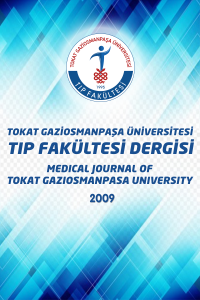Emine İkbal ATLI, Hakan GÜRKAN, Hilmi TOZKIR, Elif Gülsüm ÜMİT, Selma DEMİR, Sinem YALÇINTEPE, Engin ATLI, Ahmet Muzaffer DEMİR
Multiple Myelom (MM) Tanısı Alan Olgularda Kromozomal Değişimler
Multipl
Myelom (plazma hücreli myelom, myelomatozis veya Kahler hastalığı) kemik
iliğinde monoklonal immünglobulin (M protein) yapan plazma hücrelerinin
kontrolsüz, klonal artışı ile karakterize kronik, progresif ve letal bir hastalıktır.
Son 10 yılda özellikle genetikteki teknolojik gelişmeler sonucu, myeloma
biyolojisinin ve tedavisinde dramatik ilerleme sağlanmıştır. Tablonun hücresel
ve moleküler detayının zenginleştirilmesiyle yeni girişim ve prensiplerin
özellikle tedavide belirlenmesinde yol gösterici olmuştur. Hastalık prognozu
hastalığı oluşturan hücrelerin, morfolojisi, biyolojisi, fonksiyonu ve genetik
özellikleri gibi değişkenler tarafından belirlenir. Günümüzde, prognoz
belirlenmesinde ve tedavi seçiminde genetik özellikler de dikkate alınmaktadır.
MM‟nin gelişimi; mutasyonları, kromozomal translokasyonları ve belki de belirli
viral enfeksiyonlar ile tetiklenen çeşitli genetik anormalliklerin etkisini de
içeren çok basamaklı bir olay olarak tanımlanmaktadır. Hastalığın ilerlemesiyle
karmaşık genetik anomalilerin arttığı gözlenmiştir. Genetik değişimlerin
saptanmasının sadece klinik prognoz açısından değil aynı zamanda tedaviye
alınacak cevabı belirleyip tedavi alternatiflerin seçiminde de yardımcı olacağı
belirtilmiştir.
Anahtar Kelimeler:
Multipl myelom, genetik, kromozom
Chromosomal Changes in Patients with Multiple Myeloma (MM)
Multiple
Myeloma (plasma cell myeloma, myelomatosis or Kahler's disease) is a chronic,
progressive, and lethal disease characterized with plasma cells was increased uncontrolled
that produced monoclonal immunoglobulin (M protein) in bone marrow. In the last
10 years, especially in genetics, technological developments have resulted in
dramatic progress in myeloma biology and treatment. Enrichment of cellular and
molecular details for disease has led to new initiatives and principles leading
to choice of treatment. The disease prognosis is determined by variables such
as the morphology, biology, function, and genetic characteristics of the cells
that make up the disease. Nowadays, genetic features are taken into account in
determining prognosis and selection of treatment. Development of MM; is defined
as a multi-step event triggered by mutations, chromosomal translocations,
certain viral infections and possibly the effects of various genetic
abnormalities. It has been observed that complex genetic anomalies increase
with the progression of the disease. Genetic changes will be helpful not only
in terms of clinical prognosis but also in choosing therapeutic alternatives by
anticipating the response to be taken from the treatment.
Keywords:
Multipl myeloma, genetics, chromosomes,
___
- 1. Türk Hematoloji Derneği Multipl Myelom Tanı ve Tedavi Kılavuzu Sürüm 1.02 - Ekim 2016.
- 2. Avet-Loiseau, H. Role of genetics in prognostication in myeloma. Best Practice&Research Clinical Haematology. 2007;20(4);625-35.
- 3. Lonial S. et al. Elotuzumab Therapy for Relapsed or Refractory Multiple Myeloma. N Engl J Med 2015;373:621-31.
- 4. Kuehl, WM, Bergsagel PL. Multiple myeloma: Evolving genetic events and host interactions. Nat. Rev. Cancer. 2002;2:175–87
- 5. Lai JL, Zandecki M, Mary JY, Bernardi F, Izydorczyk V, Flactif M, Morel P, Jouet JP, Bauters F, Facon T. İmproved cytogenetics in multiple myeloma: a study of 151 patients including 117 patients at diagnosis. Blood. 1195:85; 2490-7.
- 6. Seong C, Delasalle K, Hayes K, Weber D, Dimopoulos M, Swantkowski J, et al. Prognosticvalue of cytogenetics in multiple myeloma. Br J Haematol. 1998:101;189-94.
- 7. Smadja NV, Bastard C, Brigaudeau, C, Leroux D, Fruchart C. Hypodiploidy is a major prognostic factor in multiple myeloma. Blood. 2001:98;2229-38.
- 8. Fonseca R, Miguel SJ. Prognostic Factors and Staging in Multiple Myeloma, Hematol Oncol Clin N Am. 2007:21:1115–40.
- 9. Sebastien Robioudu Pont, Alice Cleynen, Charlotte Fontan, Michel Attal, Nikhil Munshi, Jill Corre, and Hervé Avet-Loiseau, Genomics of Multiple Myeloma, Journal of Clinical Oncology. 2017;35:9, 963-67.
- 10. Steven M. Prideaux, Emma Conway O'Brien, and Timothy J. Chevassut, “The Genetic Architecture of Multiple Myeloma,” Advances in Hematology, vol. 2014, Article ID 864058, 16 pages, 2014. https://doi.org/10.1155/2014/864058.
- 11. Fonseca R, Blood E, Rue M et al., “Clinical and biologic implications of recurrent genomic aberrations in myeloma,” Blood, vol. 101, no. 11, pp. 4569–4575, 2003.
- 12. Ross FM, Ibrahim AH, Vilain-Holmes A et al. “Age has a profound effect on the incidence and significance of chromosome abnormalities in myeloma,” Leukemia, vol. 19, no. 9, pp. 1634–1642, 2005.
- 13. Ross FM, Chiecchio L, Dagrada G et al. “The t(14;20) is a poor prognosti cfactor in myeloma but is associated with long term stable disease in monoclonal gammopathies of undetermined significance,” Haematologica, vol. 95, no. 7, pp. 1221–5, 2010.
- 14. Rettig MB, Ma HJ, Vescio RA, Põld M, Schiller G, Belson D, Savage A, Nishikubo C, Wu C, Fraser J, Said JW, Berenson JR. Kaposi‟s sarcoma-associated herpes virus infection of bone marrow dendritic cells from multiple myeloma patients. Science, 1997;276;1851-4.
- 15. Mohamed AN, Bentley G, Bonnett ML, Zonder J, Al-Katib A. Chromosome aberrations in a series of 120 multiple myeloma cases with abnormal karyotypes. Am J Hematol, 2007;82; 1080-7.
- 16. Chen L, Li J, Xu W, Qiu H, Zhu Y, Zhang Y, Duan L, Qian S, Lu H. Molecular cytogenetic aberrations in patients with multiple myeloma studied by interphase fluorescence in situ hybridization. Exp Oncol. 2007;29(2): 116-20.
- 17. Talley PJ et al. Genetics in myeloma: genetic Technologies and their application to screening approaches in myeloma, British Medical Bulletin, 2015,113:15–30.
- ISSN: 1309-3320
- Başlangıç: 2009
- Yayıncı: Tokat Gaziosmanpaşa Üniversitesi
Sayıdaki Diğer Makaleler
Nadir Bir İnvajinasyon Nedeni; Burkitt Lenfoma
Ayşe KEFELİ, Ahmet AKBAŞ, Emin DALDAL, Abdullah Özgür YENİOVA, Meryem TUNÇ, Reşit Doğan KÖSEOĞLU, İsmail OKAN, Ertan BÜLBÜLOĞLU
Multiple Myelom (MM) Tanısı Alan Olgularda Kromozomal Değişimler
Emine İkbal ATLI, Hakan GÜRKAN, Hilmi TOZKIR, Elif Gülsüm ÜMİT, Selma DEMİR, Sinem YALÇINTEPE, Engin ATLI, Ahmet Muzaffer DEMİR
Dikişsiz Aort Kapak Replasmanı: Olgu Sunumu
Travmatik Sternoklaviküler Eklem Çıkığı Cerrahisi Sonrası İmplant Migrasyonu
Recep KURNAZ, Orhan BALTA, Murat AŞÇI, Kürşad AYTEKİN, Taner GÜNEŞ
Üst Gastrointestinal Endoskopi Yapılan Hastalarda Helicobakter Pylori Sıklığı
Murat YILDIRIM, Mehmet Fatih DAŞIRAN
